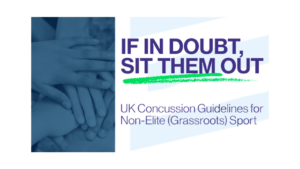Media and public perception versus clinical use of salivary biomarkers
https://x.com/NZRugby/status/1681492457798729728?s=20
Keywords: Concussion, biomarkers, injury management.
Introduction:
The identification and management of concussion in contact sport remains a critical issue for players, employers, and wider stakeholders. Sports participation should be encouraged, with the well-known myriad of health and social benefits deriving from physical exercise and human interaction through sport. However, there is increasing evidence that repeated blows to the head during contact sports places individuals long-term brain health at risk, [1,2] and has led to a predictable debate over individual risk versus population health.
Current state of play: gold standard versus emerging technologies.
In April 2023, the UK Government published its ‘landmark’ concussion guidance for grassroots sport, in which there was improved weighting on the worthy sentiment ‘If in doubt, sit them out’.[3] In other good news, the Sports Concussion Assessment Tool (SCAT-6) was recently published, and its use encouraged for baseline testing, and following suspected concussion injury for supporting concussion diagnosis.[4] Whilst the SCAT-6 is a useful tool for coaches and medical professionals aligned with sports clubs, there remains appetite for quicker and less resource-consuming concussion diagnostic alternatives.

Figure 1: UK Government concussion guidelines [3]
In July 2023, New Zealand Rugby, World Rugby, and Marker Diagnostics announced collaboration in a concussion diagnostics project. The collaborator’s goal is to improve concussion biomarker diagnostic accuracy in Women’s Rugby.[5] The press release, and indeed the Marker website, highlights the MDx.100 Concussion/ mTBI as a diagnostic product that is the first of its kind in the world which can ‘diagnose a concussion’. A claim based on three affiliated studies.[6-8] In essence, these publications highlight the potential use for salivary non-coding RNA (sncRNA) to assist our understanding of the pathophysiological response in regard to concussion injuries. The product is still undergoing clinical trials and has not yet been approved by the Food and Drug Administration (FDA).
Robust biomarkers of concussion will be of fabulous benefit to medical teams struggling to diagnose and manage affected players. However, the suggestion of diagnosing concussion with these tools feels rather premature. Despite claims and the positive framing of the success of salivary biomarkers in sport, their use clinically is unsupported by literature.[9]
The 6th Consensus statement on concussion in sport highlights Tabor et al’s recent review and states there is lack of definitive science in regard to the use of fluid-based biomarkers in the clinical setting and the use of such technologies and tests should be restricted to research settings. [9-11]
This then is perhaps another example of the early ‘hype and hope’ typical of the introduction of exciting new technologies into medicine. As traction from private firms mounts, the push to patent and mass produce biomarker technologies for a quick fix to the concussion ‘problem’ for financial gain, will hasten.
As a scientific community focused on the welfare of athletes, we must ensure that the use of biomarkers accurately provides useful and relevant information to players and healthcare professionals. Whilst the research on salivary or fluid-based biomarkers is ‘promising’, the evidence for their use in clinical assessment of concussed remains limited, both methodologically and in terms of generalisability.[11] We must ensure that the implementation of bio-marker tests in the clinical setting provides the best outcomes for the athlete patient. Therefore, it is paramount that the portrayal of the success of such new concussion ‘diagnosis’ technologies in the media by private firms and sporting bodies remain appropriately modest. Concussion identification diagnosis and management remains complex and multi-modal. Fluid-based biomarkers may indeed support future concussion identification and management, but right now, we must stick to the science.
Authors:
Tom McKeever1 David F Hamilton2
[1] School of Health and Social Care, Edinburgh Napier University, Edinburgh, UK
[2] Research Centre for Health, Glasgow Caledonian University, Glasgow UK
The authors declare no competing interests.
References:
- Russell E R, Mackay D F, Lyall D, et al. neurodegenerative disease risk among former international rugby union players. Journal of Neurology, Neurosurgery & Psychiatry 2022;93(12):1262-1268. doi:10.1136/jnnp-2022-329675
- Russell E R, Mackay D F, Stewart K, et al. Association of field position and career length with risk of neurodegenerative disease in male former professional soccer players. JAMA neurology 2021;78(9):1057-1063. doi:10.1001/jamaneurol.2021.2403
- UK Government. If in doubt, sit them out. UK Concussion guidelines for non-elite (grassroots) sport [online]. 2003. http://sramedia.s3.amazonaws.com/media/documents/9ced1e1a-5d3b-4871-9209-bff4b2575b46.pdf
- Echemendia R J, Brett B L, Broglio S, et al. Sport concussion assessment tool™–6 (SCAT6). British journal of sports medicine 2023;57(11): 622-631. doi:10.1136/bjsports-2023-107036
- New Zealand Rugby. Farah Palmer Cup teams to participate in saliva concussion diagnosis project [online]. 2023. https://www.nzrugby.co.nz/news-and-events/latest-news/farah-palmer-cup-teams-to-participate-in-saliva-concussion-diagnosis-project
- Di Pietro V, O’Halloran P, Watson C N, et al. Unique diagnostic signatures of concussion in the saliva of male athletes: the Study of Concussion in Rugby Union through MicroRNAs (SCRUM). British journal of sports medicine 2021;55(24): 1395-1404. doi:10.1136/bjsports-2020-103274
- Di Pietro V, Ragusa M, Davies D, et al. MicroRNAs as novel biomarkers for the diagnosis and prognosis of mild and severe traumatic brain injury. Journal of neurotrauma 2017;34(11):1948-1956. doi:10.1089/neu.2016.4857
- Di Pietro V, Porto E, Ragusa M, et al. Salivary MicroRNAs: diagnostic markers of mild traumatic brain injury in contact-sport. Frontiers in molecular neuroscience 2018;11: 290. doi:10.3389/fnmol.2018.00290
- Tabor J B, Brett B L, Nelson L, et al. Role of biomarkers and emerging technologies in defining and assessing neurobiological recovery after sport-related concussion: a systematic review. British journal of sports medicine 2023;57(12):789-797. doi:10.1136/bjsports-2022-106680
- Patricios J S, Schneider K J, Dvorak J, et al. Consensus statement on concussion in sport: the 6th International Conference on Concussion in Sport–Amsterdam, October 2022. British Journal of Sports Medicine 2023;57(11): 695-711. doi:10.1136/bjsports-2023-106989
- McCrea M, Meier T, Huber, D.et al. Role of advanced neuroimaging, fluid biomarkers and genetic testing in the assessment of sport-related concussion: a systematic review. British journal of sports medicine 2017;51(12): 919-929. doi:10.1136/bjsports-2016-097447